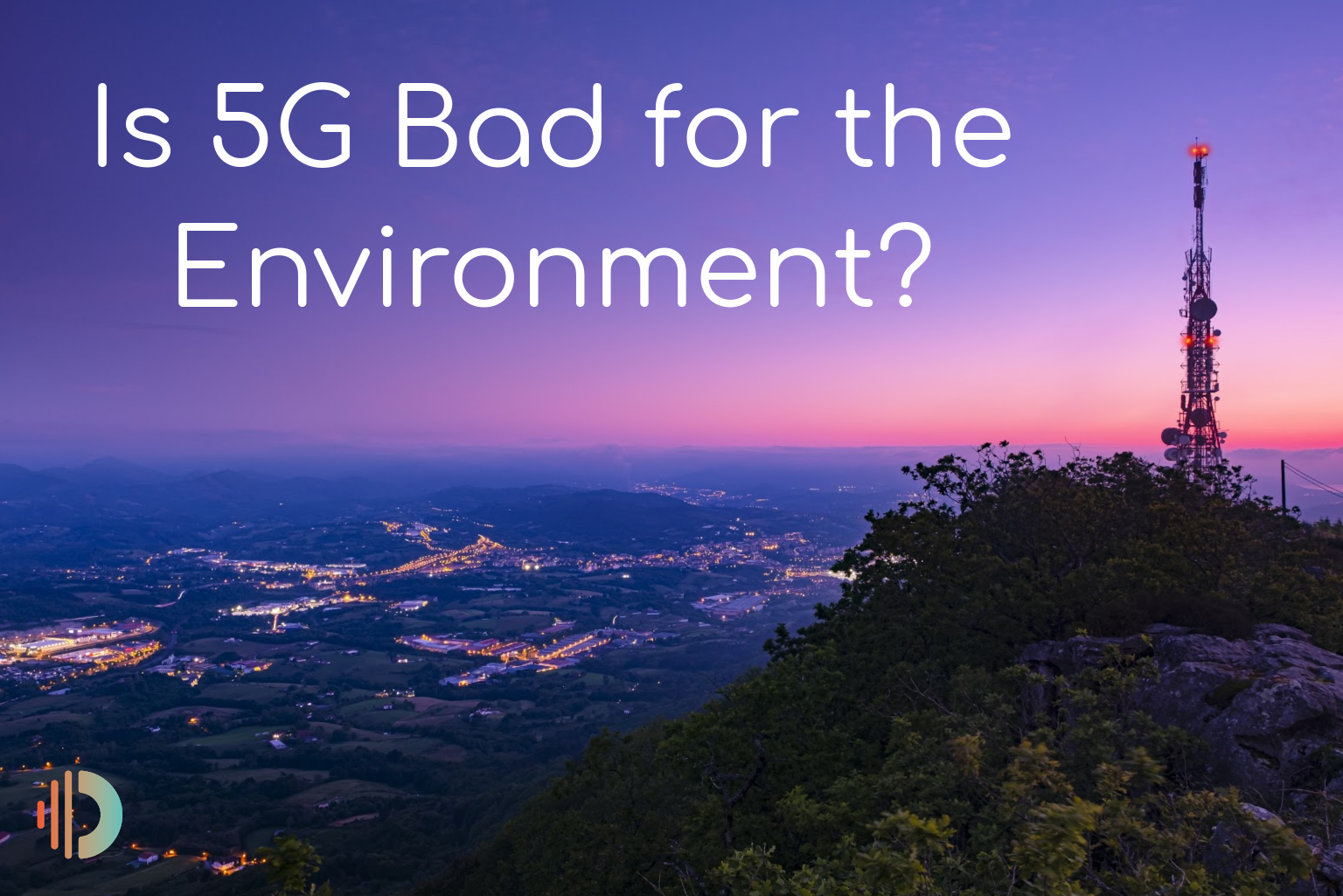Over the past few decades, our world has been rapidly shrinking - metaphorically speaking. Faster mobile and internet capabilities have brought humans from across the planet closer to each other than ever before.
And while technology like 5G promises to be a boon to global economies, communications, and our access to comfort-enhancing technology, it is important to explore how such technology will affect our environment and health in the long run.

In September 2017, an appeal by over 390 EU-based scientists requested the European Union to conduct an unbiased scientific analysis of 5G’s risks - however, this appeal was not paid heed to by the respective governments. Moreover, countries like Switzerland have put an indefinite pause on their 5G rollout due to health concerns.
In light of this information, a thorough understanding of 5G’s consequences to our health and the environment becomes even more important for the wider populace to be aware of.
Today, let’s take a look at what exactly 5G is and what its consequences could do for the health of our planet and ecology.
What Is 5G And Why Is It Being Rolled Out?
Simply put, 5G refers to the 5th generation for mobile cellular technology, and it’s poised to be the successor to the 4G mobile technology that has provided connectivity to our devices so far. 5G is expected to be rolled out in various countries - from China to The US - in a phased manner.
Why are mobile companies and global governments excited about 5G? Because it promises faster download speeds, near-instant access to the internet, and the capacity for use of more devices. The 5G network is designed to support up to 100 times more mobile traffic than 4G was - and that means higher profits and more customers for mobile network companies.
5G is expected to be much faster than 4G, its predecessor - delivering data speeds from 100Mbps (megabits per second) to as fast as 20Gbps (Gigabits per second)! Data that would’ve normally taken us hours to download in the past would be available to us within a matter of seconds.
High-Frequency Millimeter Waves: The Key to 5G’s Speed
At this point, it’s important to pause and ask ourselves - how is 5G able to transfer data at such lightning-fast speeds?
The answer is: Through high-frequency millimeter waves - a bandwidth that has never before been used in such a quantum around us.
While the 3G and 4G networks used a combination of low to medium-frequency radio waves to transmit data, 5G will be using higher-frequency millimeter waves
5G networks are slated to operate in low, medium, and high-frequency bands. While the low 5G band will use a similar frequency as the 4G, the medium band will operate on microwaves, while the high 5G band will utilize millimeter waves for data transmission.
Weak Frequency & More Cell Towers: The Impact Of 5G Densification
Even though the 5G millimeter waves are much faster at transmitting data, this plus side comes on the heels of a massive downside - these radio waves are incredibly weak thanks to their shorter wavelengths. That means, in order to ensure 100% network coverage, we will be witnessing a lot more proliferation of smaller cell towers in our neighborhoods practically every 250 meters - a practice being termed as ‘densification’.
In a study conducted by the American University in Beirut, ebanon, scientists modeled the number of 5G cell towers it would take to ensure full coverage in a 36-block area in Austin, Texas. While they saw that the 4G network took 29 cellphone towers to ensure uninterrupted coverage, it took the 5G network a staggering 100 cellphone towers for the same! This has a direct consequence on the level of ambient radiation the planet will experience.
Is 5G Bad For The Environment? Understanding Potential Impact
You may have already heard reports of scientists and environmental groups concerned about the consequences of 5G radio waves on our health and the environment - and there’s a scientific basis for this concern.
Let’s look at all the possible impact that exposure to 5G radiation could have on the environment:
Increased Ambient Radiation
Research and measurement of ambient radiation conducted in Australia, Switzerland, Belgium, and China have revealed that approximately 80% of the wireless radiation we are constantly exposed to comes from mobile network stations. Additionally, the levels of radiation currently range between .0015 W/m2 to 0.1 W/m2.
However, with the rollout of the 5G ecosystem, the numbers are set to increase exponentially. At the very least, deployment of 5G towers will expose us to 6 times higher ambient radiation than what we are currently exposed to. This could lead to an increased dissonance between our bodies and the ambient radiation surrounding us.
Increased Energy Usage
With several more 5G towers needed to ensure coverage compared to previous generation networks, we will be consuming a lot more electricity than before to keep the towers functional on a 27 x 7 basis. A calculation done to compare the energy needs of 4G, and 5G networks running revealed that 5G networks will need at least 1000 times more electricity compared to 4G networks.
That’s not all - since the 5G network will allow 100 times more mobile traffic than before, the rise in the number of consumers will also increase energy usage.
Considering that roughly 85% of the energy used in the US comes from fossil fuels, the significantly increased energy demand could lead to a drastically higher rate of carbon emissions that could accelerate our climate change crisis. At a time when a European report has concluded that a decrease of 15-30% in carbon emissions is needed to keep the global temperature rise under 2 degrees celsius, the global deployment of 5G may well worsen the ecological crisis.
Increased Manufacturing & Waste
As we said, uninterrupted 5G coverage will need the deployment of several more cellphone towers than before. In addition to this, newer 5G-compatible mobile devices will come into production, leading customers to discard old devices in favor of new ones.
We already know that several components used to produce mobile devices involve the use of scarce and non-renewable metals - and neither can mobile devices be easily recycled as other objects.
There are 6 billion mobile devices already in use today - and this number is all set to increase with the introduction of 5G. This increased production, maintenance of cellular devices and cellular towers, together with the inability to recycle certain mobile device waste has the potential to be a major contributor to climate change.
Impact on Wildlife & Ecosystems - Bees, Birds, Animals
While we are yet to test the long-term effects of 5G on our ecosystem, select preliminary studies on the impact of wireless radiation are highlighting concerns about its potential impact on the Earth’s delicate and intricately interwoven ecological system.
A study conducted by the Punjab University revealed that exposure of sparrows to merely 5 to 30 minutes of wireless radiation led to disfigured sparrow eggs. Another study by Ulrich Wanke demonstrated that bees exposed to cell tower microwaves at 900mhz for merely 10 minutes can cause the entire bee colony to collapse.
Considering that there will be several more small cell towers used in 5G than today, this could threaten the survival of several birds and bee populations - and, by extension, possibly several other species as well.
Obsolete Radiation Standards
As of today, most countries around the world follow the guidelines set by the ICNIRP (International Commission On Non-Ionisation Radiation) to set their radiofrequency exposure limits. However, with new evidence on the impact of wireless radiation coming to light in recent years, these guidelines are now being seen as obsolete. This is because the current ICNIRP limits considered that the only negative impact of wireless radiation is its thermal effects - disregarding the potential impact of wireless radiation - and now 5G frequencies - on humans, wildlife, and our ecosystems.
Bottom line
As we can see from the findings shared above, the rollout of 5G could potentially burden our planet with several negative consequences. This is why, before thinking about a global deployment, a lot more unbiased research is needed to fully understand and be aware of its long-term impacts on the well-being of the Earth.
While it’s not wrong to strive for prosperity and connectivity for all, the important question we need to ask ourselves as a species is - at what cost?
References
https://ecfsapi.fcc.gov/file/7521097894.pdf
https://jsis.washington.edu/news/what-will-5g-mean-for-the-environment/
https://blogs.timesofisrael.com/the-green-dilemma-of-5g-densification/
https://www.ft.com/content/848c5b44-4d7a-11ea-95a0-43d18ec715f5




Share and get 15% off!
Simply share this product on one of the following social networks and you will unlock 15% off!